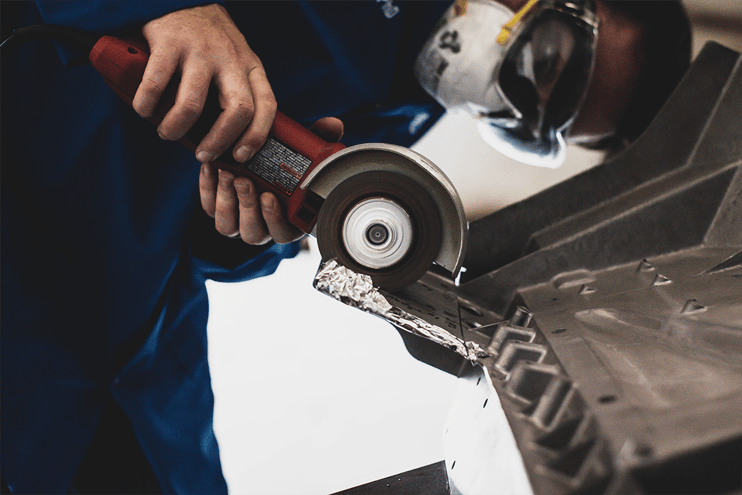When adhesion issues become apparent in a manufacturing process, they can seem to come out of nowhere. When coatings on circuit boards delaminate and cause shorts, when automotive glass doesn’t properly seal and moisture is let through, or when implantable medical devices aren’t meeting cleanliness standards consistently, it can be maddening to try to figure out what the solution is.
So, what’s causing these ongoing issues in manufacturing, and what is an effective and reliable solution?
It all starts at the surface.
A vast majority of adhesion and cleanliness issues occur due to a lack of control over the variables that affect material surface quality. This lack of control exists because, until recently, there have not been any useful methods for process control that includes:
- Thorough root cause analysis
- Parameter optimization based on quantitative surface quality specifications
- Process monitoring that inspects surface quality directly on the production line
- Verification tools that correlate to tests done in the research laboratory
There are things that can be done to halt adhesion failure and identify its source so it can be eradicated. There are new approaches to process control that involve skills and tools that redefine the best ways to optimize and monitor manufacturing processes.
Rethink your adhesion manufacturing processes with Surface Intelligence.
Skill 1: Learn to Identify How Adhesion Failure Happens
Not all adhesion failure looks the same once you take a closer look. There are three places where the break can occur, and it is very important to understand the differences in these failure areas because the way to remedy each of them is very different.
If the break occurs in the material that is being bonded, coated, or painted then this is called substrate failure. If the break is within the glue or coating itself, then this is called cohesive failure within the adhesive. If the break is at the interface between the adhesive and the bond surface, then this is called interfacial failure.
If you’re experiencing failure and underperformance in the material, you know you need a stronger material or a higher quality version of that material. If the adhesive itself is failing, then you can be certain that the supplier of the glue, coating, paint, or ink will be happy to help you find a more suitable alternative. If the failure is occurring at the interface between these two (the material and the adhesive), then you need to take a look at the surface.
To get a good picture of this, consider the Oreo cookie. The various ways that an Oreo comes apart when force is applied to it beautifully illustrate these different types of failure.
- Substrate failure: when the chocolate cookies break and the cream stays intact and remains stuck to the cookie.
- Cohesive failure within the adhesive: when the cookies come apart and both sides have cream stuck to them, indicating that the cream (adhesive/coating) broke down in some way. When testing bond strength and performance to find the limits of the bond system, this is the kind of failure you’re shooting for. Obviously, failure in actual production or use of a product is not good, but when you’re forcing failure in the testing phase, this type indicates that everything is working at the highest level.
- Interfacial failure: when the cookies come apart and only one side has cream on it while the other is clean, indicating that adhesion never occurred at the interface between the cream and the cookie.
Nearly all bond failures occur at the interfaces between the substrates and the adhesive. The surface of the substrate that needs to interact with the adhesive is actually only a couple of layers of molecules thick. That’s infinitesimally small. So if you’ve discovered failure at the convening of the material and the adhesive, then you need equipment that is sensitive to something so tiny.
Tool 1: Laboratory Equipment to Characterize the Material Surface and Identify the Contaminant
To look at a layer of the surface that is so thin, equipment must be able to sense molecular compounds that make up that surface. The use of equipment like microscopes, sectioning tools, or even just visual assessments can let you know what kind of failure you’re seeing based on where it is occurring in the material system. But when it comes to understanding WHY that failure is occurring at the interface, you need to look much closer.
This surface analysis equipment uses a few different techniques to investigate what chemicals dwell on the surface you are trying to bond to.
Contact Angle Measurement
This measurement is a classic way to determine surface energy, which is another way to talk about a material’s ability to adhere. To measure a contact angle, a drop of water is deposited on a material surface, and the angle at the point the drop meets the surface is measured. The surface energy is defined by what degree the drop is attracted to the surface (wets out and expands) or is repelled by the surface (beads up and constricts). A higher angle equates to lower surface energy which indicates lower bond strength and a lower angle equates to higher surface energy which indicates higher bond strength. This method has most often been conducted in a lab using a bench-top goniometer.
X-ray Photoelectron Spectroscopy (XPS)
This technique shoots X-rays at a surface and looks at the electrons that are ejected from the surface when the X-rays hit it, which can tell you what chemicals are on the surface.
Fourier Transform Infrared Spectroscopy (FTIR)
FTIR technology provides detailed information about the molecular structure of substances. For this test, the sample is exposed to different wavelengths of infrared light, and the instrument measures which wavelengths are absorbed. This reveals what specific compounds, such as polymers, silicone, and other contaminants, are present. FTIR identifies functional groups (chemical compounds amenable to adhesion) created or exposed by surface treatment and provides a more specific blueprint of surface composition.
Secondary Ion Mass Spectroscopy (SIMS)
SIMS is another similar technique to get information about the chemical makeup of a surface. With SIMS, a surface is blasted with an ion beam. The ejected secondary ions are collected and analyzed to give a picture of what chemicals exist on the surface.
All of these techniques are HIGHLY sensitive to the top few molecular layers, ~1-10nm thick. This is where adhesion takes place, and the presence of an unwanted chemical can spell disaster for an adhesion process.
Knowing that the contaminant is on the surface is the first step. Knowing where it is coming from is the second step. Knowing how to optimize and monitor your process to keep the contaminant from getting on the surface is the final, ongoing step.
Skill 2: Gain a Full Understanding of the Adhesion Process to Apply the Results of Scientific Analysis
This is where it is helpful to have a functional Materials Science understanding. Applying the science needed to use the equipment described above to actually solve a real-world problem is a necessary skill in manufacturing. To do this, you need to have more than just fancy equipment and scientific know-how. You need experience with manufacturing processes and surface preparation systems so proper solutions for the actual process at hand can be implemented.
All of the factors that go into a manufacturing process (which, consequently, are all part of the adhesion process as well because every aspect of production can potentially have an impact on cleanliness and adhesion) need to be competently understood to get a full picture of where contaminants might be introduced and how it can be stopped.
For instance, for an aerospace application involving laser-etched titanium, there are many factors to consider. The alloy type and oxide thickness are pertinent characteristics of the metal as well as contaminants that might be on the surface before treatment or how the structure of the material changes on the other side of preparation. It’s also vitally necessary to know what alternative or additional preparation steps are available so that the entire process can be as effective and efficient as possible. It is so easy to implement a surface preparation step that is unnecessary or ineffectual just because you were not able to measure the effectiveness of the step.
Interpreting the data expressed by surface analysis techniques into actionable steps to be carried out on the production line or in the design lab requires a thorough understanding of your manufacturing process.
Tool 2: Surface Inspection Equipment That Takes the Surface Testing Out of the Lab and Onto the Line
In order to conduct full remediation of an adhesion problem, there need to be process checks in place on the manufacturing line that quickly and quantitatively tell you definitively if your surface is ready to move to the next step.
This kind of process monitoring has been extremely difficult because manufacturers haven’t had reliable equipment or non-destructive test methods that could be used in a production setting. Click here and here for a couple of articles about legacy testing techniques that don’t meet the requirements for reliable, objective process control.
What’s needed is a method that measures surface quality quickly, accurately, repeatably, and is easy to operate.
The best method is measuring contact angles on the material surface because it is an unobtrusive test that produces actionable data with a single number. Doing this type of measurement on surfaces right on the production line requires a process called Ballistic Deposition. Ballistic Deposition is a way of building a drop on the surface in under one second by shooting a series of micro drops onto the material. This allows for highly precise control over the size and volume of the drop so measurements will be accurate, consistent, and can be calculated even on rough surfaces.
Revolutionize Your Manufacturing with Surface Quality Inspection Technology.
It’s the Combination that Counts
Each of these tools and skills on their own are not sufficient to fully address adhesion problems in manufacturing. They must be used in concert with each other so the issue can be approached from all sides and holistically managed. Materials Science knowledge incorporated with manufacturing expertise and the best surface analysis equipment is the crucial combination to diagnose the root cause of an adhesion issue and implement monitoring that’ll ensure predictable adhesion.
To learn more about how to gain the skills and tools required to truly instigate process control in an adhesion process, download our eBook on the subject: “Checklist: Adhesion Failure Root-Cause Analysis for Manufacturers.”


